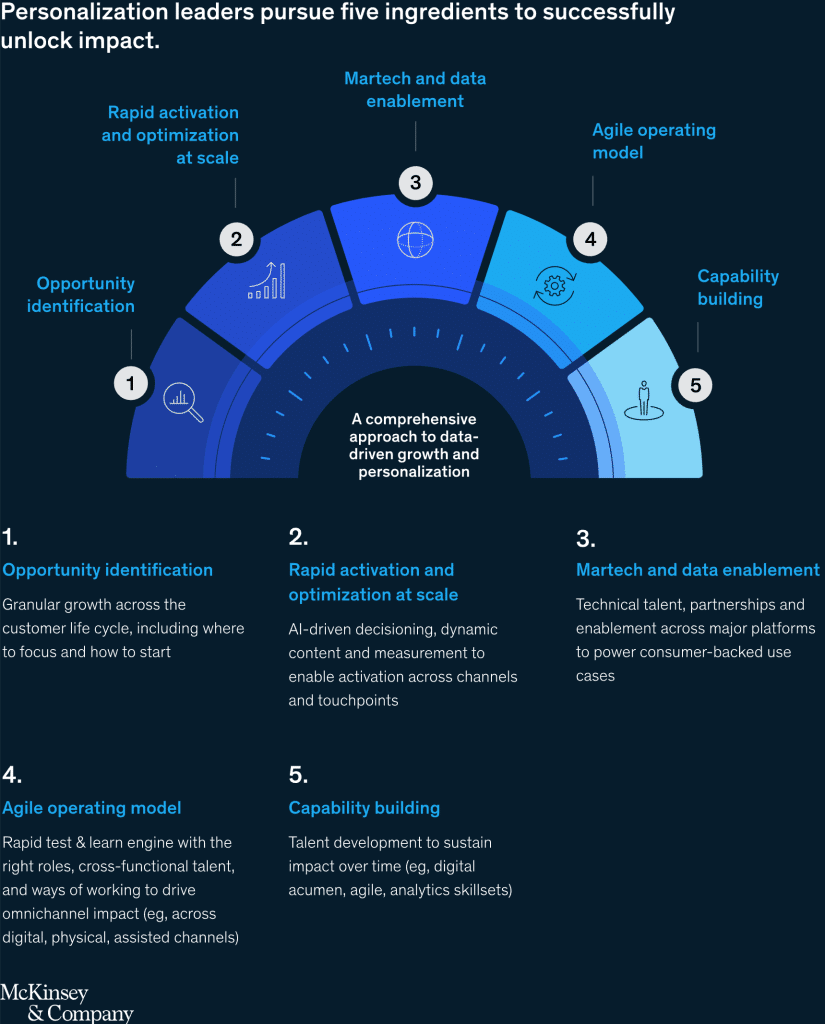As ecommerce email hyper-personalisation gains momentum, how can any enterprise take its key capabilities to drive benefits across the whole business?
To understand this, we first need to look at how hyper-personalisation has reshaped the marketing model. In the past, the success of any marketing campaign was often predicated on the number of leads generated. Technology has evolved, however, and behavioural analytics, journey visualisation and voice of the customer technologies are now coming together to enable organisations to understand and map an individual’s customer journey before intervening in a timely way when a prospect faces a challenge or opportunity.
The approach helps marketing define where it focuses its investment: on the generation of marketing assets or campaigns, for example, thereby helping the business to increase the velocity of pipeline conversion.
A recent survey by Evergage and Researchscape International – surveying 326 marketing professionals across industries and countries – revealed that marketers see the value of hyper-personalisation. 99% of marketing professionals surveyed said that hyper-personalisation helps advance customer relationships, with 78% claiming it has a “strong” or “extremely strong” impact. And 92% stated that their customers and prospects expect a personalised experience (up from 85% in the previous year).
Yet, the advantages of hyper-personalisation extend far beyond marketing itself to take in a wide range of other departments across the business including sales, customer service and product development. Conscious of these far-reaching benefits, more and more marketing departments are focused on educating the wider enterprise about what can be achieved: from higher sales conversion rates to enhanced customer engagement.

Getting ecommerce email hyper-personalisation across
If the above benefits are to be fully realised, the marketing department must communicate the benefits of hyper-personalisation enterprise-wide. In doing so, it needs to put the argument in the right context. When talking to sales, for example, the discussion should concentrate on the sales pipeline and driving up conversion rates.
Finally, when engaging with customer service, the interaction should be around how to better understand customers’ business imperatives and use that understanding to increase retention.
Vaulting the barriers
Education is important in understanding what hyper-personalisation delivers and what can be ‘demanded’ in terms of insight from the data captured. It supports the business case to invest in technology to drive hyper-personalisation.
Systems do, of course, need to capture information, take insights, and automate the next steps. Unfortunately, many legacy solutions fail to deliver. According to Gartner, only 33% feel their existing tech is useful, while over 80% are sitting on a short-sighted or outdated MarTech roadmap.
A lack of automation and interoperability is often at the heart of the issue. To ensure hyper-personalisation helps them achieve their goals, organisations must make certain their MarTech stack seamlessly integrates with the corporate system of record which is frequently the CRM.
In an as yet uncrowded hyper-personalisation marketplace, businesses must take advantage of their opportunity to engage with prospects or customers – and technology must support them in that endeavour. The latest AI and algorithmic capabilities combined with MarTech technology, and a robust enterprise resource planning (ERP) backbone can help ensure businesses have the agility they need to deliver this.
Focusing on the data
Businesses are also often challenged by the need to make data accessible enterprise-wide without compromising privacy obligations to the individuals whose data is collected. The responsibility is on marketers to transform insight into actionable intelligence. MarTech systems support that analysis and provide the marketer with the ‘what next’ to take to the rest of the organisation.
The way information is brought together to provide a 360-degree view, or as close to one, of engagement is the ultimate objective. That is why the need for systems of record, like a customer relationship management (CRM) solution, a content management system (CMS) or a digital asset management (DAM) system, to be open and integrated with leading MarTech is growing all the time. Hyper-personalisation solutions are wholly autonomous technologies believed to be at the pinnacle of such necessities, and yet often ignored in favour of lesser technologies through lack of education. The sales department, for example, should not need to be burdened by a requirement for their time and effort when a solution, knowing each consumer, and being able to nurture massive increases in lifetime customer value and average order value by itself, exists.
The goal here is to understand the intent of the prospect so that the business can engage with them appropriately and promptly. Putting identified product selections, personal to the individual receiving it, in front of that individual consumer at the perfect time is the essence of PPS. This involves getting a real insight into the existing journey and serving up meaningful content that helps inform and shape decision-making. This intelligence will make the engagement of the sales process more effective and provide the opportunity to turn a warm lead into a hot one.
Each visit to your site, or each time an email is opened moves the goalposts for that individual. It would be lovely to perceive consumers as cocooned in a silo of your making, by they are bombarded with offers and incentives across, not only your product range but a myriad of others too. If you sell fashion, it doesn’t stop the holiday companies, new car offers and the latest brand of coffee hitting them in the next advert break. But knowing what product someone is in the market for, and presenting it at exactly when the data suggests is pertinent not only wins the day, but as it’s your data (captured and utilised), your competitors haven’t had a sniff of the opportunity yet.
Enterprise-wide benefits
At the highest level, account-based marketing (ABM)/strategic accounts management is significantly informed and influenced by hyper-personalisation. The approach contributes to building out account personas and understanding and responding to the behaviours of the exact people you should be talking to at the perfect time. Indeed, marketing insight can often uncover behaviours that a traditional sales process (segmentation) may not even be aware of.
If organisations get hyper-personalised marketing right, it can benefit departments enterprise-wide. Marketing-driven hyper-personalisation helps sales drive opportunities through the pipeline. It helps to achieve longer-term customer engagement. That, in turn, allows customer service to concentrate on making accounts ‘stickier’ and reducing the propensity for customers to churn. The rate of return of goods falls through the floor when people are receiving products already identified as exactly what they want, as opposed to exactly what they think they want.
Marketing benefits too, of course, and delivering this approach improves the department’s standing within the organisation. Indeed, thanks to the success of hyper-personalisation, marketing is now widely regarded as fundamental to the sales funnel and to keeping customers engaged, informed and loyal. It is increasingly moving from a ‘we do the awareness’ piece to ‘we drive pipeline and revenue. The autonomy of hyper-personalisation now allows this enterprise-level solution to be adopted by any size of ecommerce business.
Marketing technology and the science of marketing will keep growing and moving forward. It will be increasingly focused on hyper-personalisation and alongside that, demands from the rest of the business will continue to come its way. It is yet another example of marketing setting the agenda – and helping to drive the enterprise as a whole.





